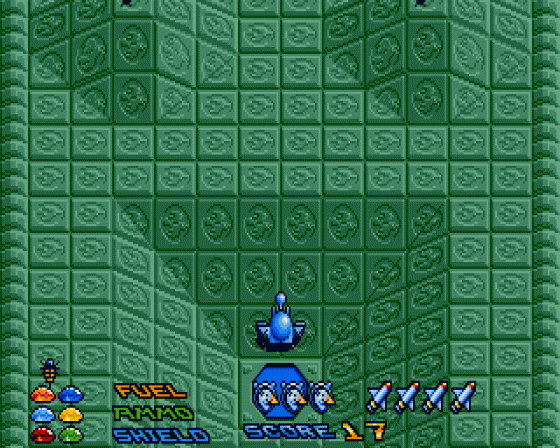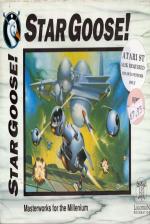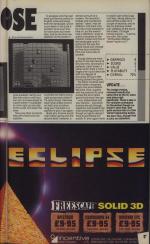
C&VG
 1st December 1988
1st December 1988
Categories: Review: Software
Publisher: Logotron
Machine: Atari ST
Published in Computer & Video Games #86
Star Goose
The first thing you have to say about Star Goose is that it does look gorgeous. You may not think the sprite design is very imaginative, you may find the gameplay gets repetitive as you encounter your fifth near identical level, and you may think some of the controls verge on the ludicrous, but you have to admit that it looks very nice. Star Goose is a nice idea for a vertically scrolling shoot-'em-up. Well executed, but marred by a lack of visual variety and a few silly mistakes.
You may say, and quite rightly, that the idea of a vertically scrolling shoot-'em-up doesn't sound very interesting anyway, but Star Goose does give the idea quite a nice little twist. Despite its looks, the goose is not a space ship at all, but a land-wagon of some sort, and as such travels up and down over the bas-relief terrain. This means that your guns are only of any use if taking out the hostile ground installations and enemy craft you encounter when they are directly in the line of sight of your pitching craft.
Your weaponry consists of normal forward-facing guns - which are not the most powerful thing ever and need to be trained on most enemies for quite some time before taking effect - and a limited supply of guided rockets. Unfortunately, these are not controlled by the joystick trigger, but by the Alternate and Caps Lock keys on the ST itself, and as such are all but useless should you - like me - be in the habit of sitting back with your feet up to play the game.

Extra ammunition can be gained by entering tunnels of varying length through heavy blue gates that appear periodically on the landscape: here you see your ship from a different angle - almost directly rear - as you scoot down a tunnel that looks like nothing so much as a spider web, picking up tokens shaped like gross eyeballs. Swing your ship from side to side and you can increase speed to a point where it is possible to circle right up one side of the tunnel and down the other.
There are other tunnels to help with shield and fuel supplies.
To progress onto the next level you have to collect six brightly coloured jewels from the landscape, which could seem to be quite a problem since your ship will slow down but never stop, and by the time one appears on the screen it could be too late to swing right across and collect it. It's okay though, because each level wraps around on itself, and so before long you'll be back in a position to pick it up again.

Quite why anyone would ever bother going onto the second level, however, is almost as much of a mystery. The mountain shapes and occasional deadly "lakes" may be different, and there may be a few more baddies to take on, but the overall look is identical. I have to admit a fondness for the metallic valleys and hills of the landscape, and in particular the way the whole mood can change as they face randomly from one colourway to another.
Though there are more sprites in the later levels at any one time, and each is perfectly clean drawn, if rather small, there is not a single one I could describe with any degree of accuracy 24 hours after having played the game.
The same could be said of the rather uninspired music and sound effects. We have, then, a game with the potential to have jointed the list of really good 16-bit shoot-'em-ups - your Sidewinders and your Xenons - but which botches the job through repetition and possibly the most annoying piece of ill thought out game design I have encountered this month. If I ever again have to reach over to the Caps Lock key, risking taking my eyes off the screen for a couple of seconds, only to see my precious rocket roar uselessly off the top of the screen, it's target having moved... it will be too soon. File under "honorable attempt, doesn't quite cut it".
Other Reviews Of Star Goose For The Atari ST
Star Goose (Logotron)
Star Goose is a Logotron shoot-'em-up from ex-Denton Design programmers Graham 'Kenny' Everett and Steve Cain, whose previous exploits include Black Lamp and Star Trek. Julian Rignall looks beyond the bas-relief horizon.
This article was converted to a web page from the following pages of Computer & Video Games #86.





